This sketch was completed by nose artist Phil Brinkman at 8th Air Force Station 174, Sudbury, England. The station was located between the villages of Great Waldingfield and Acton, two miles north-east of the village of Sudbury. The heavy bomber base had three intersecting concrete runways and fifty hardstands for the American bombers. The 486th Bomb Group flew 188 missions from this base beginning on 7 May 1944, to Liege, Belgium, and the last on 21 April 1945. This is the briefing of the 486th B. G. for one of those missions however the date was never recorded by Brinkman. It is very possible a color painting was completed from this sketch. The first 49 missions were flown in the B-24 Liberator and I strongly believe that is the time period this sketch was completed.
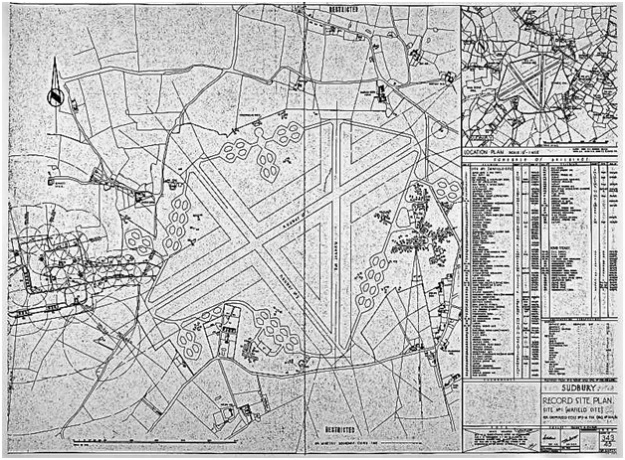

Station 174, map and Control Tower, from Roland A. Andrews collection.

The 486th Bomb Group had no WWII group badge, above insignia was created postwar [1985] for the association newsletter. The only 8th A.F. group to have two code letters, “O” [B-24] & “W” [B-17].

8th A.F. News column 1983
The 486th was activated at McCook Army Air Field, Nebraska, on 20 September 1943, and moved to Davis-Monthan Field, Arizona, on 9 November 1943, to begin training in the B-24 Liberator bombers. This is the 834th [Zodiac] Squadron roster Victory party held 11 June 1945, mostly B-17 members.





Roster list from Pilot Charlie Macgill, 834th Squadron Representative 1983

In 1975, the 8th A.F. Historical Society was a newly formed organization created by Lt. Col. John H. Woolnough, an ex-B-24 Liberator pilot, who flew the skies over Germany and survived. John understood the need to preserve the history of the USAAF “Mighty Eighth” in England during WWII, and the need to save the nose art which had been painted on so many aircraft. I wrote to John in the fall of 1975, expressing my interest in the 8th A.F. nose art and ask if I could become an associate member. The answer was yes, and for the next twenty years I would enjoy the 8th A. F. News publication, and the friendship of so many American WWII veterans, who shared their history with me.

In 1976, the 8th A. F. News advertised the search for WWII images for a new photo collection book the Historical Society was publishing, and it would include nose art. The book authored by Col. Woolnough came out in April 1978, containing 258 nose art images, including four paintings called the “Zodiac’s.” That was my first look at Brinkman nose art, but the artist name was still unknown, the Bomb Group was incorrect, and the donator Dave Mayor could give no further information. I knew at once this artist was very talented and just hoped to learn more in the future. The publication of The 8th A. F. Album was a total success which triggered a second book titled “The 8th A. F. Yearbook’, published spring 1981, also containing thousands of new photos including nose art. On page 161, a short history of the unknown “Zodiac” artist appeared for the first time with the other seven B-24 nose art paintings he completed in England. The brilliant artist was Philip Brinkman and he painted the bombers in the 834th Bomb Squadron of the 486th Bomb Group. The names of the Zodiac photo donors, Love, Andrews, Macgill, and Krieger, had no meaning to me, however that would soon change.

Phil Brinkman was 28 years of age, D.O.B. 30 March 1916.
In 1981, Col. John H. Woolnough gave me my own nose art column in the quarterly publication of the 8th Air Force News, and soon the letters from WWII veterans began to arrive. The following year, I made contact with Mark Brown and obtained his 35 mm Kodak color slide film, including the seven images of the Zodiac squadron, and the artist himself painting “Aries.” [B-24H-15-FO, serial 42-52693, 2S-O] This was possibly the second “Aries” he completed, Sudbury, England, July 1944.


Even in this black and white image, it becomes obvious that Brinkman was at the same level or better than his “fine” art colleagues, and he still deserves to be recognized by the high-art-world of today. He served his country in time of war, painted eleven huge murals in England, painted outdoors on at least 22 bombers, and his innovation of the “Zodiac” art was very innocent, [good taste] showing very little nudity. I would later learn he was trained at the Washington University School of Arts, St. Louis, American Academy of Fine Arts, Chicago, and Grand Central Academy of Arts, New York City. He was in fact a highly trained “Fine” artist, but his girl nose art is totally forgotten, and that is wrong.
My next huge break came when I made letter contact with the pilot of the B-24 Virgo, Charlie Macgill.





Virgo B-24H-15-FO, serial 42-52532, 2S-K

The next letter gave me the address of Brinkman, however the three letters I addressed to him were never answered, as Charlie had warned. I pressed on regardless.

From 1983 to 1986, I continued to received letters, new 8th Air Force contacts, photos of the Zodiacs, information, and the new republished poster by Charlie. My new friend became a life-long partner in the research of the Zodiac squadron and we would meet in 1996, and keep in contact until his passing. There is so much more to tell about Charlie, but I do not have the space.
Tail Gunner Sgt. Robert G. Arnold

Three photos from Bob Arnold collection – 1982-84
My next important letter and photos came from Sgt. Robert G. Arnold, the tail gunner who flew 29 missions in B-17G, serial 42-98008, with nose art “American Beauty” by Phil Brinkman. They nicknamed her “Rose-Lady” and this will be covered in detail later in the B-17 section. Robert had made contact with artist Brinkman in 1981, and for some reason he always received a reply letter with good information. He also completed a color painting of his B-17 in 1979, [from the above image] and this possibly put him in good favour with Phil Brinkman. [That’s just a guess on my part, but artists tend to support each other] Bob copied and sent me all his Brinkman letters from 1981, and later in 1986, copied my questions and sent a letter to Brinkman to answer. A most unusual method of conducting research, but it worked and 486th history was slowly saved. Bob Arnold was another important historian who experienced B-17G combat over Germany and then did his best to save and preserve it.
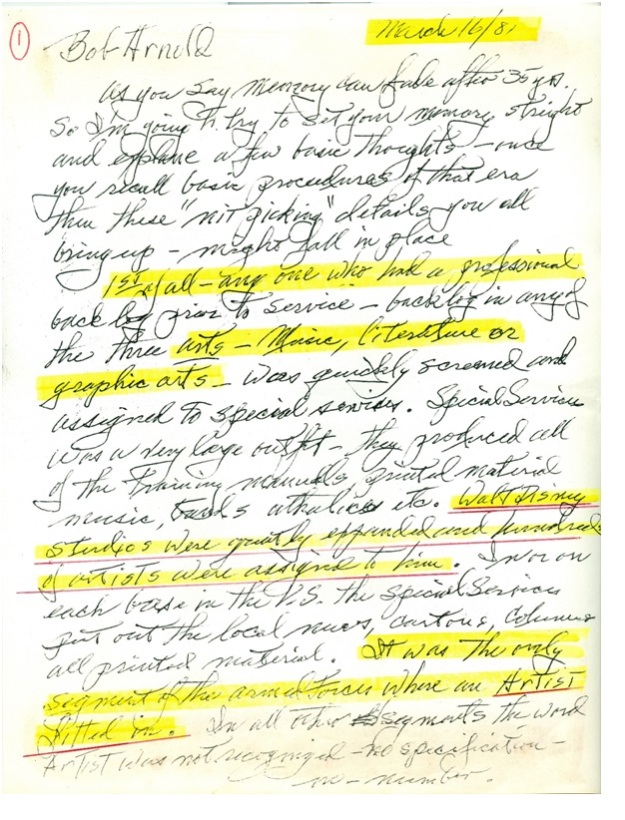


The Phil Brinkman letters provided me with good background information and the type of person he was.
Philip Brinkman was born in St. Louis, MO, 30 March 1916, and attended three ‘fine’ art schools, Washington University School of Art, St. Louis, American Academy of Fine Arts, Chicago, and the Grand Central Academy of Arts, New York City. He was a master in painting any subject in a grand mural scale, and he knew his painting style was the best. For a short time, he was employed by advertising agencies in St. Louis and Chicago, then he hit the open road. He admits he was a maverick, spent six years travelling around the eastern seaboard painting, and drinking, then he was drafted into the service, and had no place to fit. The Special Services was the only place an artist fit in, and it was full of men producing local newsletters, cartoon art, and training manuals. Brinkman was in a class by himself, stating – “They were all round holes, and I was square or vice versa”, so I ended up with guard duty or K.P. I was stationed at Davis-Monthan Army Air Field at Tucson, Arizona, in mid 1942. I was stuck in an Air Force Guard Squadron, so I immediately began to convince the Commanding Officer the base needed some large mural art, and this eliminated the guard and K.P. duties. I answered only to the C.O. and painted murals in the NCO mess, the officer’s club, recreation hall, USO stage backgrounds, and just kept out of sight and active. On 9 November 1943, the 486th Bomb Group arrived at Davis-Monthan Field to begin B-24 training. The mural art of Brinkman was everywhere and his creative talent caught the eye of Captain W. D. Howell, Squadron Commander of the 834th Bomb Squadron. After meeting with Cpl. Brinkman, Capt. Howell ask if he would like to become a member of his squadron and paint nose art, but he would be required to leave for England when the squadron finished their training. Phil wanted out of Davis-Monthan and jumped at the chance to go overseas as a member of the 486th Bomb Group. Capt. Howell arranged for a transfer under his command, and Brinkman became a member of the 834th Bomb Squadron. This was where the idea of B-24 “Zodiac” Squadron all began at Tucson, Arizona, and possibly two were painted.

In 1982, Crew Chief Harold Love sent this information to the 8th A. F. News, however it was only half right and half wrong. [B-24H-15-FO, serial 42-52545, 2S-M]
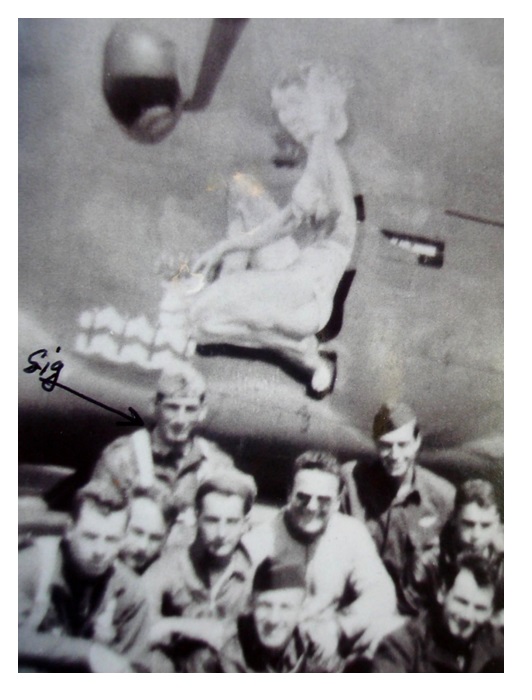
Pilot Lt. Sighrd L. Jensen Jr. Commander of B-24H-15 serial 42-52545, “M”, confirmed his Liberator nose art was started at Davis-Monthan Field by Phil Brinkman, but the water sign lady was never painted in the nude. This image was taken in early March 1944, just before the air echelon moved to England. The lady “Aquaria” is wearing panties and bra for her trip using the southern route to Africa, then north to England. The nose art was finished by Brinkman at Sudbury, England, possibly the second “Zodiac” painting completed. The order of painting from this point on is unknown, but thirteen were completed by July 1944. Two Leos, two Aries, and no Taurus.

This clear B & W image was sent to me by pilot Lt. Jensen Jr. in 1983.

Colorised version done by Pierre Lagacé
On 24 May 1944, the 8th Air Force flew mission #367, and the Third Bomb Division despatched 490 Liberator bombers on visual attacks of German airfields around Paris. This was the 7th mission flown by the 486th Bomb Group, who reported to their bomber stations at 04:25 hrs and started engines 10 minutes later. Take-off began at 05:00 hrs and 39 bombers were airborne for St. Cyr, France Luftwaffe airfield led by Major Norton. Twenty-eight B-24s hit the primary target and eleven hit the secondary target, dropping 33 tons of bombs. Pilot Jensen in Aquaria and pilot Macgill in Virgo flew next to each other. They would remain true friends for the rest of their lives and Jensen kept a copy of the Form 483 M, showing the tail view of the formation to Paris on 24 May 1994. It contains a good amount of information on this one mission. The copy was passed on for my research in 1983.
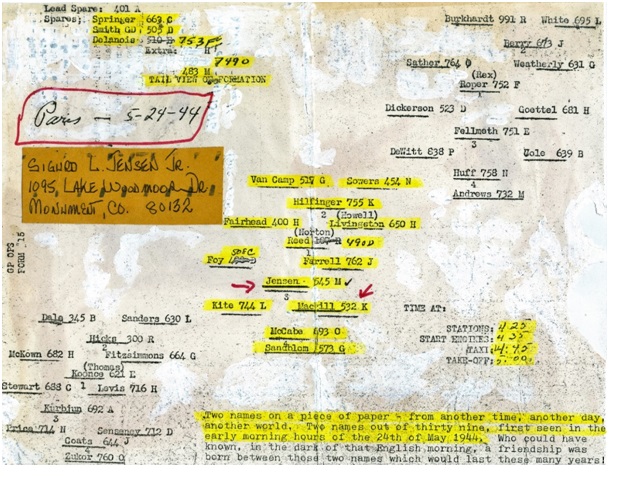

Phil Brinkman was always seen carrying his sketch pad and when he saw something he liked, or an idea came to him, he would stop and capture the moment with his pencil. Later this sketch was turned into a beautiful painting. I wonder who Verva Whitehorse was, and if her painting remains forgotten on a wall in England today? Most of the B-24 Zodiac nose art began in his sketch pad, which shows the amazing talent he processed in creating a nose painting from a pilot’s simple idea, expressed to him at Sudbury, England. On 16 March 1981, Phil sent this sketch pad to Rob Arnold and ask him to donate it to the 8th Air Force Historical Society, where I guess it still remains? Bob then made copies and sent them to me.
On 13 February 1984, my friend Charlie passed on the address of Zodiac “Cancer” pilot Col. Harry Paynter, USAAF Retired, Arlington, Virginia.

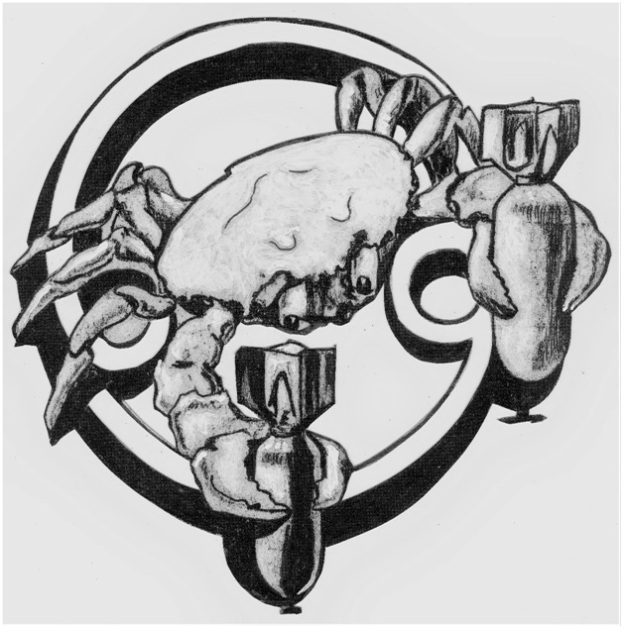
When Harry Paynter talked with Phil Brinkman, they were standing in front of his B-24H-15-FO, serial 42-52650, and Phil was sketching away as per normal. Harry told him his sign was Cancer and he didn’t want a sexy nude, but something with the crab sign. This is a copy of the very first sketch which was rejected by pilot Paynter, for the simple reason it had two bombs. Phil ripped the sketch out and gave it to him, then went to work on a crab holding a single bomb and that was approved by Harry. The painting was completed on his bomber just days before they would fly their very first mission, 7 May 1944. This date would also become the first day target #342, where over nine-hundred 8th Air Force bombers would attack Belgium, and only the second time over 1,000 American fighters and bombers took to the air war over Europe. Thirty-six B-24’s from the 486th dropped 55 tons of bombs on Liege, Belgium, and all returned safely to Sudbury, England.


Harry Paynter believes these two images of fueling “Cancer” were taken on the 5 May 1944, just two days before they flew their first mission. That gives a little time frame for Brinkman’s painting of Cancer.


This “Taurus” the Bull drawing was on the back of the above Harry Paynter sketch.

The sixth mission was flown to Etampes Mondesir, France, on 23 May 1944, and this slide image [showing six white bombs] was recorded by Col. Mark Brown possibly that same day. Cancer was one of 465 Eighth Air Force B-24s which struck the target, 39 from the 486th B. G., who dumped 111 tons of bombs on the target. This marked the first time 8 A.F. P-51 fighters [14 aircraft] escorted the American bombers to and from the target area, with one fighter shot down.
The sketch of “Taurus” on the backside of the Harry Paynter [under wing sketch], indicates Brinkman was painting his Taurus the Bull nose art around the end of May 44.

Brinkman began his Taurus nose art painting three times on three different B-24s, but they never returned, and his bull art was never finished. Three of his Taurus drawing images survive, two in his sketch book, and this is the second, possibly done for his second attempt at painting his bomber nose. The 834 Bomb Squadron set an 8th Air Force record with no personnel or aircraft lost on their first 100 missions. So, that means the three missing Taurus B-24 aircraft were possibly transferred to the other 486th B. G. squadrons, containing the Taurus half finished Zodiac nose art.
On 20 May 1944, two B-24s crashed on take-off, serial 726 and 691. This was followed on 28 May 44, with two more lost to German anti-aircraft fire, 42-52764 and 345. On 8 June 44, another B-24 crashed at Gosfield. I believe three B-24s from the 834th B. G. were transferred to other squadrons as replacements and that is why they never returned. At least the Brinkman sketch book contains a third, and the very best image of the missing “Taurus” the Bull looking down doing target study.

I recall this sketch was first believed to be a bombardier looking at his aiming point, however it was also pointed out, the bull could also be a member of the 8th A. F. photo interpreters doing target study. These members spent long hours studying strike photo images [the reason for the pillow] and drawing new target maps of Germany. Brinkman wrote the word “Hi!” I will leave the final conclusion to readers.

These are 446 Bomb Group 8th A. F. photo interpreters at work conducting “Target Study” in 1944. I believe the original pilot wanted to honor these men and that is the reason behind the Brinkman sketch.
Between 1939 and 1945, five factories produced 18,482 Liberators which were always being modified from time to time, and this needed some form of overall control for identification. The factories assigned each bomber a set of block numbers in multiples of five and this allowed for the later changes at modification centers. The first assigned was the letter B- then 24- model H- block number 15- and letters for plant it was constructed in. The five plants were assigned letters which were applied to the identification code, Consolidated/San Diego – CO, Consolidated/Fort Worth – CF, Douglas/Tulsa – DT, Ford/Willow Run – FO, and North American/Dallas – NT. The 486th B. G. were assigned B-24H in olive and grey factory finish camouflage from block 15 and later B-24J aircraft in natural metal finish. The 834th Bomb Squadron bomber aircraft were all assigned in camouflage paint and should be identified by each identification number data stencil painted on the nose area of each bomber. For some reason all these data sections, which were painted on in the factory, were painted over when the aircraft arrived in England.
This identification data block shows up many times in the image of the aircraft nose art, but not in the 834th Bomb squadron, and that caused problems when two Leo images turned up.

In 1981, Bob Arnold sent the above images to Phil Brinkman who wrote he had painted both and he knew the pilot, but he had no idea why there were two “Leo” nose art paintings on two different bombers, with the same pilot. The answer would be contained in a Mark Brown 35 mm color slide.

This is possibly the second Zodiac painted by Brinkman in April 1944, with serial 42-52768. She was a B-24H-15-FO, built at the Ford/Willow Run plant. The third mission was flown on 23 May 44, and this image was taken by Mark Brown on or after that date. The name Zodiac was never painted. The next mission on 24 May, pilot William Hillfinger flew 42-52755, 2S-K, to Paris.

The painted over squadron 2S can be seen while the tail marking, X in square, is that of the 493rd B. G. at Debach, England. Leo was just transferred and has now completed 15 missions.

Phil Brinkman completes a new sketch for Hillfinger and a new sexy lady appears with her Leo the Lion. Serial 41-29605, she is a B-24H-15-CF built at Consolidated/Fort Worth.

The first Pisces sketch which Brinkman completed and was rejected, so he did a second sketch.
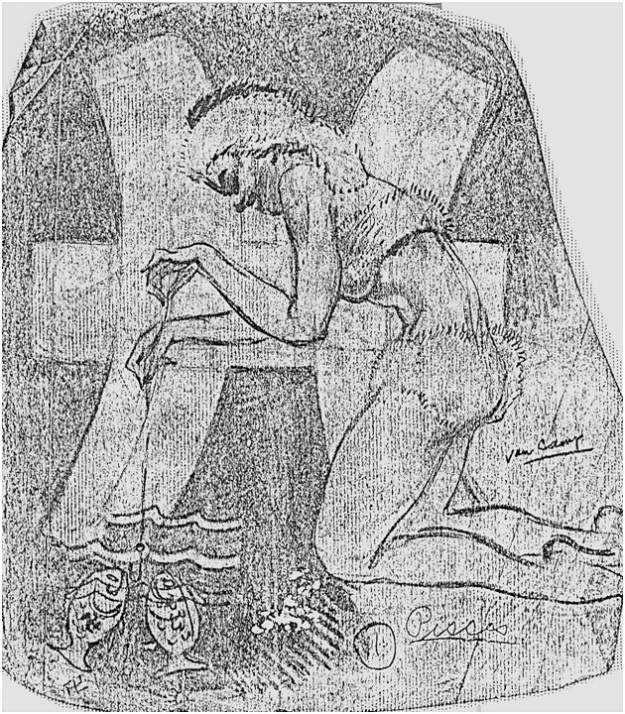
This was drawn on very thin [onion skin] copy paper, from pilot Van Camp collection.

This sketch contains the same idea, just a different pose, again rejected.

B-24H-15-CF, serial 41-29517, what a beauty.

Colorised version done by Pierre Lagacé

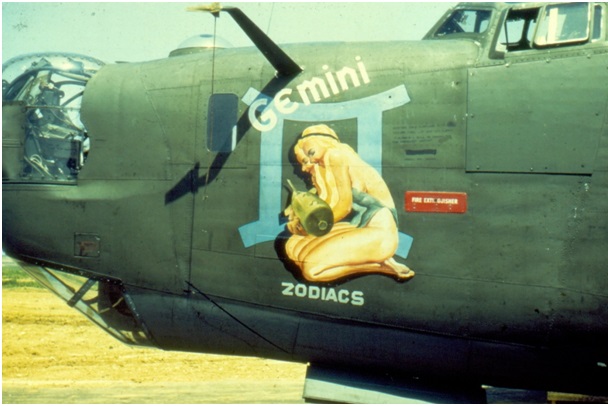
I must admit, I prefer the original sketch of the “Twins” much better. B-24H-15-CF, code 2S-D, pilot Fuller.

Scorpio B24H-15-FO, serial 42-52762. 2S-J, photos sent to Bob Arnold by Phil Brinkman.

Phil Brinkman images – sent to Bob Arnold 27 March 1981.
The Official 834th Squadron “Scorpion” Insignia was adopted after the end of the war, May or June 1945. At the 11 June 45, Victory Party Program, a Brinkman sketch appeared, plus a cloth badge of the Scorpion design. [Sketch from 1983 – Bob Arnold]

I am positive this was the Brinkman nose art sketch, which was later adopted as the official 834th Badge or Insignia. The cloth badge was submitted from a Tech/Sgt. in the Administration staff by name of George Bollington, who also flew as a tail gunner. Brinkman confirmed his original sketch in March 1981 letter to Bob Arnold.


Information for historians. This is the only 486th Squadron Insignia created from an original Phil Brinkman nose art sketch, which became B-24H nose art. I feel this insignia should be credited to artist Phil Brinkman and I don’t care who submitted the design [copied] or whatever. It’s Brinkman copyright.


Libra, B-24H-15-FO, serial 42-29605. 2S-E, pilot Lt. Foy

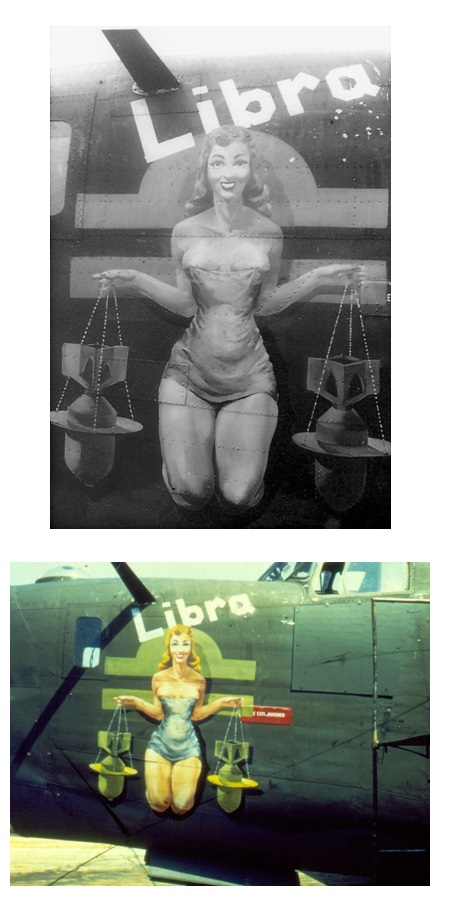

B-24H-15-FO, “Ding Dong Daddy from Dixie” had completed two missions. Top of bomb on left.
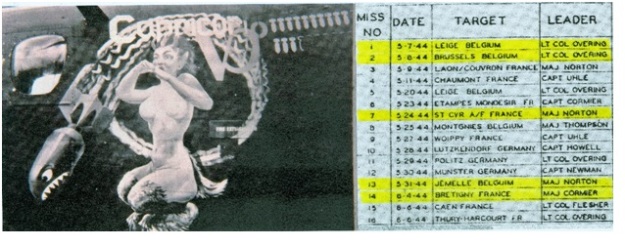
Louis Armstrong recorded “I’m A Ding Dong Daddy from Dumas” in July 1930, and the hit was re-recorded by other famous artists during the war years. The song title was altered to appear as nose art on B-24H-15-FO, serial 42-52744, and became “Ding Dong Daddy from Dixie.” When Brinkman began his nose art painting of Capricorn, the B-24 had flown [painted two bombs] two missions, which possibly indicates the date around 11 May 1944. During this period the 483rd did not fly any missions for nine straight days, which was a perfect time for aircraft painting. Brinkman then painted five more mission bombs, for a total of seven. As Brinkman completed his painting the bomber had flown thirteen missions, with a possible date around early June 1944.
This is the only group of photos which gives a possible time-frame for starting and completing a B-24 nose painting by Brinkman in England. I believe Phil worked on two or three nose art paintings at one time, walking back and forth from bomber to bomber. It appears an aircraft oil painting took from seven to ten days to complete, using regular brush and standard oil paints.

Painting notes from letter 10 November 1986, last letter received from Robert Arnold.
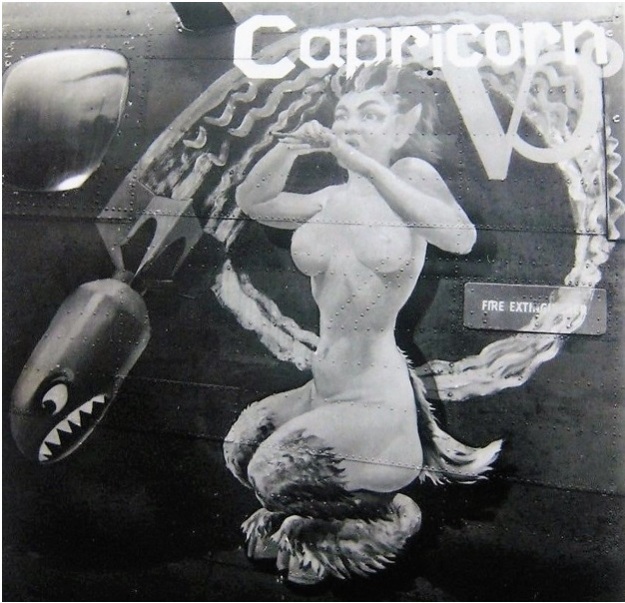
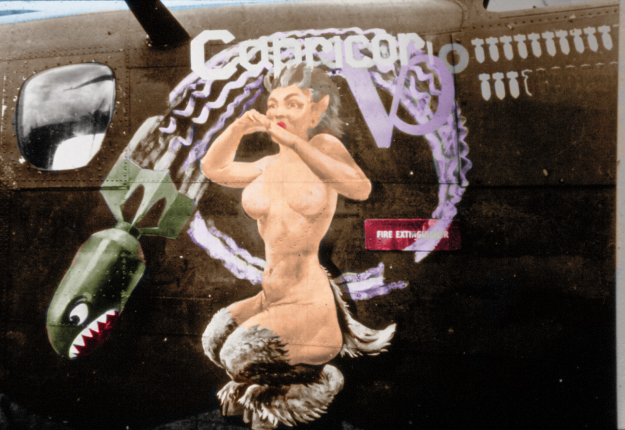
Colorised version done by Pierre Lagacé
The fine art of Phil Brinkman created for the crew, who picked “their” design, and the women portrayed as they wanted her topless, but as Phil stated – “In good taste.” This painting was created on an aircraft outdoors, in the “real” world of England at war, not in the safe confines of some art community in the United States. It was created to show the appealing image of a half-women, because the crew wished to claim her as their good-luck lady, and also attract the attention of other 8th Air Force bomber crews. It boosted morale for thousands of Americans, plus Allied aircrews who flew off and never returned to base. It was not created in today’s high society warped fashion world of stone faced, robotic, starved girls, or in a distorted feminism idea which Hollywood has created due to male control, power, and sex. It was created by a rigorously trained artist who was a genius in painting a rich technique, but today bureaucrats are afraid to show this ‘fine’ nose art to children in our military museums. Horse “Apples.” It’s the very same as ‘family approved’ nude fine art.

Sagittarias, B-24H-15-CF, serial 41-29400, pilot Reed, one of 738 built by Consolidated at Fort Worth, but her nose art spelling should read SAGITTARIUS. Brinkman later corrected the spelling.
Did Brinkman paint twelve or thirteen Zodiac B-24H nose art images during WWII?

Phil Brinkman started his Zodiac paintings in Tucson at Davis Monthan, and then concluded his nose art painting at Sudbury, England, around early July 1944. When the 486th Bomb Group were assigned bombers they received aircraft from the Ford production plant B-24H-15-FO, between serial 42-52303 to 42-52776, which constructed 1,780 B-24H models. Other aircraft assigned came from the Consolidated plant at Fort Worth, where 738 B-24H-15-CF models were constructed with the 486th assigned block H-15 within serial numbers between 41-29336 to 41-29606.
The B-24H was the first model Liberator to be equipped with an electric nose turret on the production line. In 1976, Lt. Col. John H. Woolnough received the above [right] image of B-24H, serial 42-52765, from a Mr. Michakczyk of the 486th B. G. The image was taken at Tucson, when the new B-24H bombers were being painted by Brinkman, and it was identified as the first “Aries.” This image appears to be a very new B-24H with the factory chalk marks still present on the nose area. This bomber arrived in Sudbury, England, on 24 March 1944, and flew with the 486th B. G. on 7 May 1944. While the lettering and Ram painting clearly show the style of Phil Brinkman, he could never recall ever painting this nose art. This research was conducted back in 1981-1984 and both Roland A. Andrews [486th B. G. expert in England] and Bob Arnold [tail-gun] expressed to me that Brinkman had a drinking problem, and that is why he could not recall some historical things, which he called “nit-picking.” At one time the 833rd Squadron was formed as a special “Lead Crew” Pathfinder Squadron, and a few Zodiac bombers were transferred, and I believe this involved the first painted Aries 42-52765.


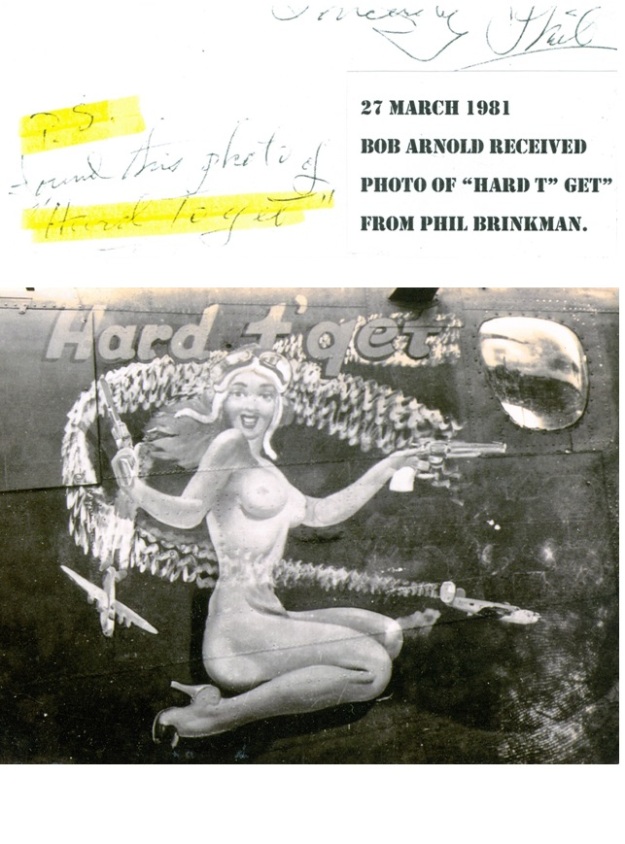
From the private collection of Phil Brinkman
“Hard T’ get”

The little red haired lady with a pair of Colt 44’s was B-24H-15-FO, serial 42-52753, Lt. Simmons, hardstand #3, Sudbury, 535th Bomb Squadron, code F6-H. This nose art was completed for another squadron and for that reason Brinkman would chage $40 to $50 to the members of the 535th Squadron.

This replica painting was started in Mexico in the winter of 2014, however I have not yet finished it. It was painted on the original B-24J skin from serial 42-78579, which served as a training bomber at Walla Walla Army Air Base, Walla Walla, Washington. On Sunday, 30 September 1944, it was on a night training flight when the crew of six flew into the 5,500 ft. summit of Mission Ridge and all perished. In July 2013, Mack Parkhill’s brother and grandson hiked to the site of the crash and recovered a few sections of original Liberator skin. Two skin panels were mailed to me, and on one, I completed a reproduction of Charlie Macgill’s “VIRGO for his friend Mack Parkhill. This is the unfinished second panel, which I have dedicated to nose artist Phil Brinkman and to the original crew of six who were killed in the mountain crash 30 September 1944.
While I do not have the talent of Phil Brinkman, I hope it gives some idea of what the little red haired lady with two six shooters [pair of 44s] looked like. Pun fully intended.

The summary of 486th Bomb Group B-24 missions in WWII, the last flown in Liberators. It is believed fourteen [confirmed 13] of these B-24 Liberators carried nose art painted by Phil Brinkman. They attacked the ball-bearing industry and airfields in S/W Germany, 8th A. F. Mission #486, same as the bomb group. On 1 August 1944, the 486th B. G. began flying the B-17G from block 75-BO, and new Brinkman nose art would appear on at least eleven Flying Forts in the 486th.
Next time,



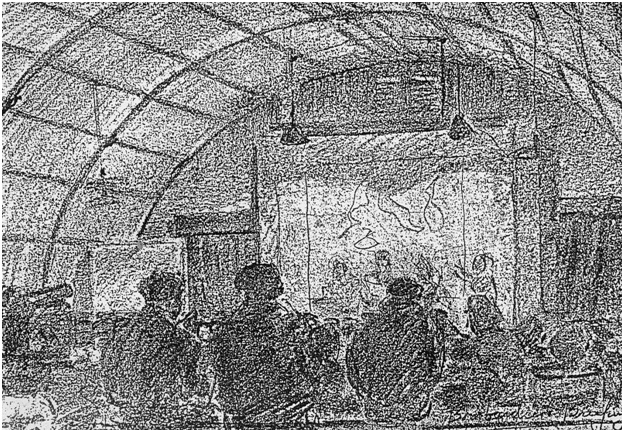
I read your hard work on Brinkman with interest. I recently obtained from a uk auction a fragment of a USAAF flying jacket. On it is painted the nose art of the zodiac liberator Scorpio. A member of the crew, I thought, but this is where it gets interesting. The panel has been roughly hacked with a knife from the back of the jacket. Attached to it was a lapel pin for The Reichsluftschutzbund (RLB) (National Air Raid Protection League), and an old German printed label on war quality paper that reads Amerikanischer terrorflieger. Although Scorpio crashed in March 1945 the crew all evaded capture. March in Austria is not the time to abandon your jacket so I’m guessing it belonged to the original crew (certainly looks like Brinkman’s hand) who was shot down later in the war (and from the way it was cut, possibly didn’t survive the crash). Any ideas who it could have been?
Graham
LikeLike
I will get back to you later Graham. I will send your message to Clarence Simonsen.
LikeLike
Thanks.
LikeLike
I just wrote Clarence.
LikeLike
Clarence wrote this in reply…
Thanks Pierre,
Please tell Graham to contact the 8th Air Force Museum in England, he will find it online. They should be interested in saving this history and receiving an image of the A-2 jacket art?
I would also contact the 8th A.F. Association in the United States and even the 486th B.Group and pass this history on for preserving. They should have all the crew names, etc.
I am no longer involved with the 8th A.F. I will always be proud as I was part of the original members, who are now all deceased.
My Blog research was just a small attempt to save ‘their’ past nose art painted by the greatest nose artist Phil Brinkman. I’m not sure anyone cares anymore, everything is about money and not history.
Cheers – Clarence
LikeLike